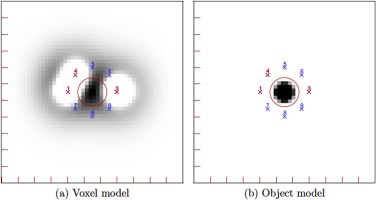International Journal of Greenhouse Gas Control ( IF 4.6 ) Pub Date : 2019-12-19 , DOI: 10.1016/j.ijggc.2019.102804 James Gunning , Jonathan Ennis-King , Tara LaForce , Charles Jenkins , Lincoln Paterson

|
The inversion of cross-well time-lapse pressure tests is investigated as a monitoring technique for locating CO2 plumes in the subsurface. Fast inversion methods are possible which treat the gas plume as either a constant-pressure or reduced diffusivity region. However, neither constant-pressure nor diffusivity-barrier approaches are adequate for modelling the full behaviour of the plume dynamics, especially the late time pressurisation of small plumes. The saturation dependence of the flow is dominated by the compressibility contrast, which justifies the use of an approximate mixed-phase flow equation with saturation dependence confined to the compressibility terms. This fast proxy flow model enables the construction of efficient inversion methods using either low dimensional object–based representations of the plume, or voxelised models exploiting gradients from nonlinear adjoint theory. It allows the inclusion both of cross-well and single-well responses.
The inversion algorithms are then tested on a simplified three-dimensional full-physics simulation model of CO2 injection, and give a 2D image for the most probable plume location. By using subsets of the full well data, it is shown that the inversion algorithms can detect and locate the plume with only three monitoring wells, but even two monitoring wells have utility given prior information. More certain delineation of the plume geometry occurs as the number of wells increases, and it is most clearly inferred when the testing well geometry fully surrounds the plume.
中文翻译:

用于CO 2羽流检测的贝叶斯试井二维层析成像反演
研究了井间延时压力测试的反演方法,作为一种监测CO 2定位的技术地下的羽状流。可以将气体羽流视为恒压区域或扩散率减小区域的快速反演方法。但是,恒压方法和扩散阻隔方法都不足以对羽流动力学的全部行为进行建模,特别是对小羽流的后期增压。流动的饱和度依赖性由可压缩性对比决定,这证明了使用饱和度受限于可压缩性项的近似混合相流动方程的合理性。这种快速的代理流模型可以使用低维基于羽状对象的表示形式或利用非线性伴随理论中的梯度的体素化模型来构建有效的反演方法。它允许包含井间响应和单井响应。
然后在简化的三维二维全物理模拟CO 2注入模型中测试反演算法,并给出最可能羽流位置的2D图像。通过使用完整井数据的子集,表明反演算法仅用三个监测井就可以检测和定位羽流,但是即使有两个监测井也具有先验信息。随着井数的增加,羽状几何的轮廓更加确定,最清楚地推断出测试井几何形状完全围绕羽状。











































 京公网安备 11010802027423号
京公网安备 11010802027423号